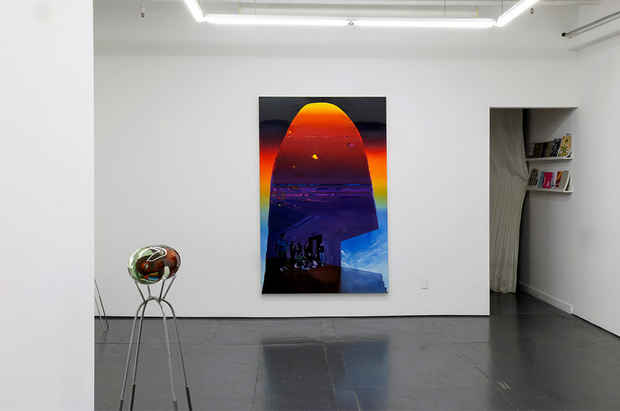Nooshin Rostami and Shantia Zakerameli “The Ripening Sun in the Basin of the Present”
Transmitter

This event has ended.
Curated by Lila Nazemian
Transmitter is thrilled to present The Ripening Sun in the Basin of the Present, an exhibition of new sculptures by Brooklyn-based artist Nooshin Rostami, as well as paintings by Isfahan-based artist Shantia Zakerameli, curated by Lila Nazemian.
The work of Rostami and Zakerameli explores the properties, philosophies and lessons pertaining to light. Additionally, throughout their individual practices, they probe the writings of twelfth century mystic and philosopher Sohrevardi. As the founder of the school of Illuminationism –where light is the source of all knowledge – Sohrevardi’s teachings are rooted in his belief that consciousness must be attained through both discursive and intuitive means. This approach, based in logic as well as the senses, is present throughout the creation and subject-matter of Rostami’s sculptures and Zakerameli’s paintings.
On view by Rostami is an installation of six glass sculptures in sequence, an iteration of a larger version forming a circle with twelve pieces. The glass spheres tell the story of the earth and the sun through the passage of time. Each object evolves slightly in shape, color and size, to recount different moments of this perpetual orbital relationship. Rostami created these works in 2022 while on a year-long fellowship at Urban Glass where their experimental approach to fabrication pushed the boundaries of light and glass as material. In an interview, Rostami explains these works in further detail: “When light hits the curved surface of a rotating concave mirror it bends into different spatial forms, one of which resembles the number 8 or an infinity sign. This form also appears as a spatial phenomenon called Analemma – the diagram of the sun’s position when observed from a fixed location on Earth at consecutive times of the year. During my fellowship, I collaborated with a team of glass blowers to test and perfect a technique that involved shaping the empty space within liquid glass, capturing the essence of infinity through the molten material. This was a meticulous and challenging process of gently applying pressure to the trapped air inside the hot glass and carefully cooling it off just before the bubble loses its desired shape.” Rostami’s work is ultimately a sensory journey, since observing one’s surroundings through these sculptures dramatically shifts the experience of one’s perception.
Exhibiting for the first time in the U.S., Zakerameli’s paintings present scenes where light materializes through both figuration and abstraction. Intricately rendered landscapes, interiors, and figures blur in and out of each other through color gradients, reflecting the philosophical attributes of light and perception. Light serves as a conduit that transcends barriers, both physical and metaphysical. This further connects to socio-political and historical concepts, in which Zakerameli’s work explores the modern ubiquity of the nation-state system and the ramifications of dividing peoples and cultures along fabricated identities. In Untitled, a quadriptych painting, Zakerameli explores these political ideas through a series of reveries. Starting from a scene based on a photo taken in California, two renowned Iranian scholars discuss their longing for Iran; the painting unfolds as a diagram of various dreams and aspirations. Other vignettes include geological views of the earth, closeups of soil and rocks, as well as depictions of figures on a mountain in Iran looking out onto the horizon and others in a remote province, pointing towards the night sky. Zakerameli often couples geometric forms with color gradations when moving between abstraction and figuration. He employs this technique in his second work on view, Untitled, which is a dialogue between interior and exterior worlds. In this piece, individuals in a gallery discuss a sky being projected on a wall. The light from the projector however, tears through the barrier between the inside and outside, revealing the actual exterior sky. These oscillating dimensions are cyclical; glitches and pixelations in the abstractions ultimately revert the scene back into the gallery space.
Through their works, both artists have captured attributes of light by slowing down the experience of time and movement. In Zakerameli’s paintings, this effect is depicted through color gradients that mimic light’s characteristics–gradients merge into landscapes but more importantly, they highlight light’s effective blurring of all boundaries and distinctions.The light that was used through a camera in the Pacific coast to capture a photograph that is the initial point of Zakerameli’s quadriptych is the same light that travels across the earth’s surface to illuminate Iran’s mountainous plains. Rostami’s sculptures similarly evoke the cosmic spectrum, from the atomic level of quantum energies, to the immensity of celestial movement. Their sculptures are more than art objects, they are lenses that can be used as both micro and macro optical instruments. They are scientific generators of realities that manifest time. Rostami utilizes these tools for drawing with light in immersive performances that engage the senses through sound and sight.
Media
Schedule
from September 16, 2023 to October 15, 2023